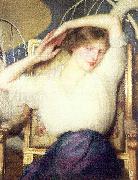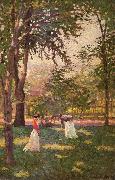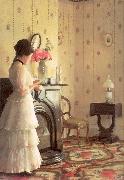|
Here are all the paintings of Paxton, William McGregor 01
| ID |
Painting |
Oil Pantings, Sorted from A to Z |
Painting Description |
| 19792 |
 |
Portrait of Enid Hallin |
Oil on board. |
| 19795 |
 |
Reverie |
1917
Oil on canvas. |
| 19793 |
 |
The Album |
1913
Private collection. |
| 19790 |
 |
The Croquet Players |
1898
Oil on canvas
Private collection, Boston. |
| 19791 |
 |
The Front Parlor |
1904
Oil on canvas. |
| 19794 |
 |
The Other Room |
1916
Oil on canvas
El Paso Museum of Art. |
|
|
| Paxton, William McGregor
|
| American Painter, 1869-1941
was an American Impressionist painter. Born in Baltimore, the Paxton family came to Newton Corner in the mid-1870s, where William's father James established himself as a caterer. At 18, William won a scholarship to attend the Cowles Art School, where he began his art studies with Dennis Miller Bunker. Later he studied with Jean-L??on G??rôme in Paris and, on his return to Boston, with Joseph DeCamp at Cowles. There he met his future wife Elizabeth Okie, who also was studying with DeCamp. After their marriage, William and Elizabeth lived with his parents at 43 Elmwood Street, and later bought a house at 19 Montvale Road in Newton Centre. Paxton, who is best known as a portrait painter, taught at the Museum School from 1906 to 1913. Along with other well known artists of the era, including Edmund Charles Tarbell and Frank Benson, he is identified with the Boston School. Like many of his Boston colleagues, Paxton found inspiration in the work of the seventeenth-century Dutch painter Johannes Vermeer. Paxton was fascinated not only with Vermeer's imagery, but also with the system of optics he employed. He studied Vermeer's works closely, and discovered that only one area in his compositions was entirely in focus, while the rest were somewhat blurred. Paxton ascribed this peculiarity to "binocular vision," crediting Vermeer with recording the slightly different point of view of each individual eye that combine in human sight. He began to employ this system in his own work, including The New Necklace, where only the gold beads are sharply defined while the rest of the objects in the composition have softer, blurrier edges.
|
|


